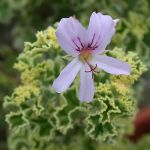| Common Name: |
Lemon Geranium |
| Botanical Name: |
Pelargonium crispum |
| Genus: |
Pelargonium |
| Family: |
Geraniaceae |
| Location: |
S Africa |
| Cultivation: |
Well-drained, neutral to alkaline soil in sun. Pelargonium crispum, P. odoratissimum, and P. tomentosum tolerate partial shade. Plants may be cut back in early spring. If grown outdoors in cool climates, they may also be cut back before bringing in for the winter. Leafhoppers, aphids, spider mites, and whitefly may attack plants under cover. |
| Propagation: |
By softwood cuttings in spring, late summer, or early autumn. |
| Harvest: |
Plants are cut in late summer and distilled for oil. Leaves are picked as required. |
| Height: |
60-70cm (24-28in) |
| :Width |
30-45cm (12-18in) |
| Variations: |
Major
(fingerbowl geranium)
Has larger leaves, to 2.5cm (1in) long. Ideal for finger bowls instead of lemon slices. |
Minor
Has a stiff, compact habit. |
Peach Cream
Has a fruity scent and irregularly creamy white variegation, with some leaves entirely cream, or overlaid with cream. |
Prince of Orange
Has a compact habit and fan-shaped, orange-scented leaves. Derived from P. crispum before 1880.
Height: 25-60cm (10-24in)
Width: 15-30cm (6-12in) |
Variegatum
Has crinkled, cream-edged leaves. Suitable for training as a standard, reaching 1m (3ft). |
|
| Hardiness: |
Min. 2°C (36°F) |
| Parts Used: |
Leaves |
| Properties: |
An aromatic herb with a lemon aroma. |
| Culinary Uses: |
Leaves may be infused to make tea, and used fresh to give a lemon flavor to fish, poultry, soups, sauces, sorbets, ice cream, fruit punch and vinegar; also placed at the bottom of cake pans to infuse batter with lemon flavor. |
| Economic Uses: |
Leaves are dried for potpourris and herb pillows. |
| Bibliography: |
Encylopedia of Herbs by Deni Brown Copyright ©: 1995, 2001 Dorling Kindersley Limited pg.304-305
|

